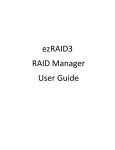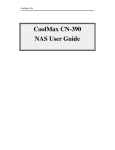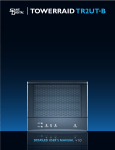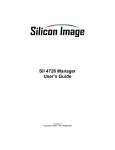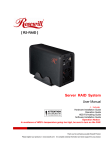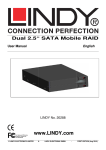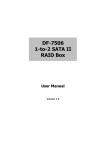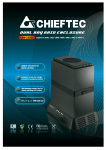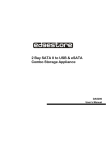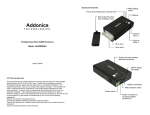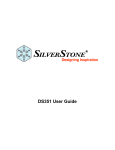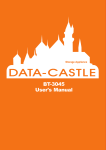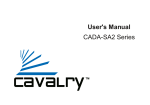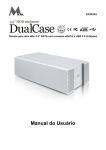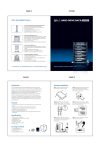Download CoolMax CD-320 storage enclosure
Transcript
1 Introducing the CoolMax CD-320 Product Overview The CoolMax CD-320 is available from leading storage partners in pre-configured set-ups with eSATA host connections; some also include USB host connections. Simply open the box and connect the appliance with an appropriate host cable; it’s that simple. The CoolMax CD-320are available in four different configurations, each offering a different subset of features and capabilities, as shown in the following table: Table 1 - Available Product Features by Chip Type Feature SiI5744 SATA Yes USB Yes JBOD Yes BIG Yes FAST Yes SAFE Yes SAFE33 Yes SAFE50 Yes Drive Locking No All Others Features Yes Throughout the remainder of this manual, all descriptions and screen images reflect the SiI5744, which supports all product features. All references to “rotary switch” refer to the settings of the CONFIG[2:0] pins, which can be hard-strapped to a specific configuration, or dynamically selected using a rotary switch selection. CoolMax CD-320 is powered by Silicon Image’s industry-leading SteelVine™ architecture (see Figure 1) which provides: • SATA or USB host connectivity • eSATA capable on all SATA ports • Enhanced data protection • High-performance storage • Plug-and-play functionality • Virtualization capabilities (to map the physical hard drives to virtual volumes) • Cascading • Automatic disk rebuild (when one or more SAFE volumes are configured) • Drive Locking (Data Security) • Backup Button DOWNLOAD LINK: http://www.coolmaxusa.com/download/NetTool/CD_320_Steelvine_Management_Tool.ZIP The SteelVine Manager software includes a graphical user interface (GUI) for Windows, Macintosh and Linux operating systems that allows you to configure, manage, and monitor the CoolMax CD-320, hard disk drives, and virtual volumes. The CoolMax CD-320s can also be configured, managed and monitored without using the SteelVine Manager software. Figure 1 - CoolMax CD-320 Architecture Populated with two external Serial ATA (eSATA) hard disk drives (HDDs), each CoolMax CD320 can manage as much as 2,000 gigabytes (i.e., 2 terabytes) of data, depending on the capacity of the hard disk drives that are installed. By combining multiple CoolMax CD-320s in a daisy- chained hierarchy structure, you can increase the total storage capacity of your system. For more information refer to CoolMax Storage Policies on page 6 and Cascading on page 12. SATA Features The CoolMax CD-320 provides the following Serial Advanced Technology Attachment (SATA) features: • Automatic negotiation between SATA I (1.5Gbps) and SATA II (3.0 Gbps) • Serial ATA 2.5 specification compliance (Gen2m) • Serial ATA Port Multiplier 1.1 specification compliance For detailed information about SATA technology, refer to the following specifications online: • Serial ATA: High Speed Serialized AT Attachment, Revision 1.0a • Serial ATA II: Extensions to Serial ATA 1.0a, Revision 1.1 • Serial ATA II: Port Multiplier, Revision 1.1 The Serial ATA web site is http://www.serialata.org/. USB Features The CoolMax CD-320 provides the following Universal Serial Bus (USB) features: • USB 1.0 and USB 2.0 specification compliance For detailed information about USB technology, refer to the following specifications online: • Universal Serial Bus Specification, Revision 1.1 • Universal Serial Bus Specification, Revision 2.0 • The USB Organization web site is http://www.usb.org/. Using the CoolMax CD-320 Note: Unit is in Virtual Drive default configuration that will show only 8gb storage. Unit will need to be reset to clear the default configuration. Reset: Power on the unit and wait till the flash of red led turns to light green. You will need to reset the unit to clear the default Virtual Configuration. Press and hold the reset button located at the bottom and beside the storage policy switch. Wait till the led light flashed 2 solid red; turn off and on the unit to take effect. You can use the CoolMax CD-320 in any of the followings ways: Appliance-Only Mode This mode allows you to use the CoolMax CD-320 with the device’s LEDs to indicate status, without using the SteelVine Manager GUI software. To select a storage policy in this mode the first time that a new factory-shipped product is used, ensure that the hard disk drives are installed, set the rotary switch on the back of the CoolMax CD-320 to the desired Storage Policy (not the GUI selection) and turn on the power. To change the storage policy thereafter, set the rotary switch to the desired position and press the recessed Mode Change push-button to create the new virtual volume(s). Creating new virtual volumes will destroy any existing data that existed on the previous volume, but expanding an existing BIG volume will not destroy any existing data. Status-Only Mode This mode allows you to use the CoolMax CD-320 with the SteelVine Manager GUI to monitor the status of the appliance (i.e., temperature, fan speeds, storage capacity, and RAID mode of the desired hard drive), but not make Storage Policy configuration changes through the GUI. To select a storage policy in this mode the first time that the product is used, ensure that the hard disk drives are installed, set the rotary switch on the back of the CoolMax CD-320 to the desired Storage Policy (not the GUI selection) and turn on the power. To change the storage policy thereafter, set the rotary switch to the desired position and press the recessed Mode Change push-button to create the new virtual volume(s). Note that creating new virtual volumes will destroy any existing data that existed on the previous volume. GUI Mode This mode allows you to use the SteelVine Manager GUI to configure the Storage Policy and other settings as well as monitor the status of the appliance (i.e., temperature, fan speeds, storage capacity, and RAID mode of the desired hard drive). To select this mode the first time that the product is used, ensure that the hard disk drives are installed, set the rotary switch on the back of the CoolMax CD-320 to the GUI position and turn on the power. In this mode, no virtual volume(s) will be created until the storage policy and volume selections are made through the GUI. To change from GUI mode to some other fixed storage policy thereafter, set the rotary switch to the desired position and press the push-button to create the new virtual volume(s). CoolMax Storage Policies You can configure the CoolMax CD-320 to use any of the following Storage Policies to map the appliance’s physical hard drives to virtual drives that are visible to the host computer. The virtual drives are called volumes in the GUI. The host operating system treats each volume as if it were a single physical drive. This virtualization allows you to overcome restrictions that are imposed by physical hard drives, such as speed, storage capacity or data storage reliability. BIG The BIG storage policy concatenates a series of physical hard drives as a single large volume; resulting in a seamless expansion of virtual volumes beyond the physical limitations of singularly connected hard drives. CoolMax CD-320 BIG storage policy delivers maximum storage space without a single large capacity and costly hard drive. Any node within a cascaded configuration can be set to BIG. For more information about Cascading refer to Page 12. Hard drive A and B are concatenated into a single virtual volume in the Figure below with a storage capacity that is equal to the sum of each of the physical hard drives A and B. CD-320 Figure 2 - BIG storage policy sample configuration It is also possible to create a BIG volume using only a single hard disk drive connected to Port 0, and then increase the storage capacity of the volume later by adding another hard disk drive (or another CoolMax CD-320 with at least one hard disk drive) to Port 1 and pressing the Mode Change push-button. The new disk blocks of Port 1 will be concatenated to the end of the disk blocks of Port 0, and any data that is stored on the existing BIG volume will be preserved. However, it is not possible to expand an existing BIG volume by adding another hard disk drive to Port 0 and still preserve any existing data on that volume. JBOD The JBOD (Just a Bunch of Disks) storage policy enables each hard drive to be seen separately as one drive. When using a SATA host controller, JBOD should only be used if the SATA host controller provides Port Multiplier (PM) support. If a host is not PM-aware, only a single drive is presented (drive 0). No such limitation if using a USB host connection. JBOD storage policy is available in the SteelVine Manager for a standalone (non-cascaded) Storage Processor or the top-level node of a cascaded configuration, but not for subordinate nodes. Even though you can use the rotary switch to select JBOD mode for any node in a cascaded configuration, only the first JBOD volume of any subordinate node is detected by your host. Therefore, selecting JBOD mode for any subordinate node is not recommended. In a JBOD configuration, the CoolMax CD-320 directly exposes each physical drive. CD-320 Figure 3 - JBOD storage policy sample configuration FAST The FAST storage policy distributes access across all hard disks, also called striping (equivalent to RAID 0). FAST presents the best data speed but no data redundancy. FAST storage policy accelerates hard disk operating speed by using many disks in parallel. Hard drive data segments are written to different disks simultaneously which increases performance while sacrificing data redundancy. To implement the FAST storage policy, the CoolMax CD-320 creates a single virtual volume that is striped across both hard drives, with a storage capacity that is equal to the sum of both hard disk drives. It is possible to set any node within a cascaded configuration to FAST, although there is no performance benefit when using multiple layers of striping. CD-320 Figure 4 - FAST storage policy sample configuration SAFE The SAFE storage policy stores all data in duplicate on separate drives to protect against data loss due to drive failure. One drive mirrors the other at all times, equivalent to RAID 1. Every write operation goes to both drives. SAFE provides the highest level of data protection for critical data that you cannot afford to lose if a hard drive fails, but halves the amount of storage capacity because all data must be stored twice. The resulting storage capacity of the virtual SAFE volume will be equivalent to the size of one hard drive (if both drives are the same) or the smaller of the two drives (if they are different). If one drive fails, the SAFE volume is still usable, but it is in a vulnerable state because its mirrored hard drive is inaccessible. When the offline drive comes back online, the appliance begins a rebuild process immediately to restore data redundancy. A message box appears in the GUI to notify you that a rebuild is in progress. Although the volume remains available during the rebuild process, the volume is susceptible to data loss through damage to the remaining drive until redundancy is restored at the end of the rebuild and verification process. Host access takes precedence over the rebuild process. If you continue to use the SAFE volume during the rebuild, the rebuild process will take a longer time to complete, and the host data transfer performance will also be affected. Any node within a cascaded configuration can be set to SAFE, but it is more efficient to use the SAFE policy at the lowest possible level within the hierarchy. In this mode, the Schedule/Verify option is enabled. It is also possible to create a SAFE volume using one hard disk drive connected to Port 0 of the CoolMax CD-320, although no mirroring will occur until a second hard disk drive is connected to Port 1. With only one hard disk drive connected, the SAFE volume will be available, although no data protection will be provided until a second hard disk drive is connected. CD-320 CD-320 Figure 5 - SAFE storage policy sample configuration SAFE33 The SAFE33 storage policy creates two virtual volumes; one SAFE volume and one BIG volume, and should be used when you need the high reliability for some of your data (with the added overhead of mirroring) but you don’t need high reliability for the remainder of your data. SAFE33 reduces the cost of additional hard drives in operations where non-critical data could be lost without severe consequences. SAFE33 uses a SAFE volume that is mirrored across two hard drives to protect your critical data in the event a hard drive failure. If one drive fails the SAFE volume is retrievable although the BIG volume is not. When you replace the failed drive, the SAFE volume is automatically rebuilt on to the replacement drive. For example, if you are using a video editing application that stores the primary source data and also uses some temporary storage for editing, you need protected storage that is offered by SAFE for the primary source data, but you do not need protected storage for the temporary data. Therefore, the combination of SAFE and BIG would be the most efficient utilization of your available storage capacity. If either hard drive fails the primary data stored on the SAFE volume would still be available whereas the temporary data stored on the BIG volume would be lost. The size of the SAFE volume of a SAFE33 policy will be one-third of the size of one hard drive (if they are equal) or one-third of the size of the smaller (if they are not equal.) The size of the BIG volume will be the combination of all remaining capacities. Example: In Figure 6 below, assume that Drives A and B are 300 GB each. When the SAFE33 Storage Policy is selected, the resulting virtual volumes will include SAFE volume of 100 GB (1/3 of 300 GB) and a BIG volume of 400 GB (the remaining capacity after allocating 100 GB from each of the hard drives). CD-320 Figure 6 - SAFE33 storage policy sample configuration When using a SATA host connection, you must have a PM (Port Multiplier) aware host adapter when using SAFE33 on the top level node of a cascaded configuration so that ALL volumes can be detected by the host. If your SATA host adaptor is not PM aware, then ONLY the SAFE volume will be detected and the BIG volume will not be accessible. No such limitation exists when using a USB host connection. For subordinate nodes in a cascaded configuration, it is possible to configure a SAFE33 storage policy, although you will only see the SAFE volume from that node. Therefore, the SAFE33 storage policy should only be used at the top-level node of a cascaded configuration. Refer to the Capacity Expansion for SAFE33 & SAFE50 section below for additional information about expanding the storage capacity for the SAFE33 Storage Policy. SAFE50 The SAFE50 storage policy creates two virtual volumes; one SAFE volume and one BIG volume, and should be used when you need the high reliability for some of your data (with the added overhead of mirroring) but you don’t need high reliability for the remainder of your data. SAFE50 reduces the cost of additional hard drives in operations where non-critical data could be lost without severe consequences. SAFE50 uses a SAFE volume that is mirrored across two hard drives to protect your critical data in the event a hard drive failure. If one drive fails the SAFE volume is retrievable although the BIG volume is not. When you replace the failed drive, the SAFE volume is automatically rebuilt on to the replacement drive. For example, if you are using a video editing application that stores the primary source data and also uses some temporary storage for editing, you need protected storage that is offered by SAFE for the primary source data, but you do not need protected storage for the temporary data. Therefore, the combination of SAFE and BIG would be the most efficient utilization of your available storage capacity. If either hard drive fails the primary data stored on the SAFE volume would still be available whereas the temporary data stored on the BIG volume would be lost. The size of the SAFE volume of a SAFE50 policy will be one-half of the size of one hard drive (if they are equal) or one-half of the size of the smaller (if they are not equal). The size of the BIG volume will be the combination of all remaining capacities. Example: In Figure 7 below, assume that Drives A and B are 300 GB each. When the SAFE50 Storage Policy is selected, the resulting virtual volumes will include SAFE volume of 150 GB (1/2 of 300 GB) and a BIG volume of 300 GB (the remaining capacity after allocating 150 GB from each of the hard drives). CD-320 Figure 7 - SAFE50 storage policy sample configuration When using a SATA host connection, you must have a PM (Port Multiplier) aware host adapter when using SAFE50 on the top level node of a cascaded configuration so that ALL volumes can be detected by the host. If your SATA host adaptor is not PM aware, then ONLY the SAFE volume will be detected and the BIG volume will not be accessible. No such limitation exists when using a USB host connection. For subordinate nodes in a cascaded configuration, it is possible to configure the SAFE50 storage policy, although you will only see the SAFE volume from that node. Therefore, the SAFE50 storage policy should only be used at the top-level node of a cascaded configuration. Refer to the Capacity Expansion for SAFE33 & SAFE50 section below for additional information about expanding the storage capacity for the SAFE50 Storage Policy. Capacity Expansion for SAFE33 & SAFE50 When using the SAFE33 and SAFE50 storage policies, it is possible to begin with a single hard disk drive, and then add a second hard disk drive to increase the size of the BIG virtual volume (and to provide the data protection of the SAFE volume using mirroring) when additional hard disk storage capacity is added. CD-320 CD-320 Figure 8 – Example of SAFE33 or SAFE50 Capacity Expansion Figure 8 shows an example of a single-drive SAFE33 or SAFE50 Storage Policy configuration consisting of a 100GB hard drive (Drive A) connected to Port 0. Assuming that a SAFE50 Storage Policy is used, a 50GB SAFE volume and a 50GB BIG volume will be created, although the SAFE volume will be in a degraded (non-mirrored) state. When Drive B is connected to Port 1 to increase the storage capacity, the SAFE volume will be able to complete the mirror by using 50GB from the Drive B, and the remaining capacity will be added to the existing BIG volume, increasing it from 50GB to 100GB. Important: Some additional steps will be needed on your host computer system to allow it to recognize a volume that has been dynamically expanded – refer to Appendix A through C for more information. Cascading The cascading feature allows you to configure as much storage capacity as you need; as few as two drives or as many as eight. Refer to Figure 9 for some examples of cascaded configurations. Cascading allows you to customize the amount of storage capacity without the financial, technical and logistical downsides of traditional backup and restore methods. Multiple CoolMax CD-320 can be daisy-chained together in a hierarchical structure that combines the storage capacities from all units. By combining multiple CoolMax CD-320 in a cascaded configuration, multiple device/drive configurations can be presented as virtual volumes, which results in a larger storage capacity than upgrading to larger physical hard disk drives. You can cascade CoolMax CD-320 up to 3 levels deep, with one top-level node, up to two second-level nodes and up to four third-level nodes. Any combination of hard drives and/or CoolMax CD-320s can be connected in a cascaded configuration. You can connect any of the following combinations of devices to a SteelVine processor: two hard drives, one hard drive and one CoolMax CD-320 , or two CoolMax CD-320s. Note: The SiI5733 CoolMax CD-320 can only be used as a top-level node; it cannot be a subordinate node within a cascaded configuration. Figure 9 shows various CD-320 device configurations that can be assembled using multiple CoolMax CD-320and multiple hard disk drives. CD-320 CD-320 CD-320 CD-320 CD-320 CD-320 CD-320 CD-320 CD-320 CD-320 CD-320 CD-320 CD-320 CD-320 Figure 9 - Cascading drive configuration options Note: The SATA link between cascaded nodes in a cascaded configuration is not Port Multiplier aware. Therefore, although it is possible to configure lower-level nodes (subordinate to the top-level mode) to use JBOD, SAFE33 or SAFE50 Storage Policies, only the first volume for that node will be visible to any upper-level node. When creating virtual volumes with a cascaded configuration, ensure that all hard disk drives are properly installed and that all SATA connections between the cascaded nodes are secure. You must then configure the desired storage policy on the bottom-most nodes in the cascaded configuration, before configuring any of the upper-level nodes. After the bottom-most nodes have been configured and become ready, you can configure the middle nodes. Finally, the toplevel node must be configured after all subordinate nodes are ready. You can specify the storage policy for each node through the SteelVine Manager GUI or by setting the rotary switch and pressing the Mode Change push-button. If you wish to change the storage policy for any node or expand the storage capacity of any node by adding more hard disks or CoolMax CD-320 s, you must reconfigure each node that has changed in the same bottom-up manner, and you must press the mode change push-button to place the new storage policy into effect. The top-level node must be the last item that is changed in a cascaded configuration. In addition, you may need to perform some supplemental steps on your host system so the expanded volumes can be recognized at the file system and OS level. Refer to Appendix A, B or C for information about to perform those steps on Windows, Macintosh and Linux systems. Cascading also allows you to combine multiple CoolMax CD-320 to create more advanced RAID configurations for high-availability, such as RAID 10 (striping and mirroring), as shown in Figure 10. The top-level node should be set to FAST (RAID 0) mode for striping, and the subordinate nodes should be set to SAFE (RAID 1). In this configuration, the subordinate nodes provide the protection of mirroring, and the top-level node provides the performance benefits of striping. If one of the hard disk drives ever fails, the SAFE volumes from the subordinate nodes will still be valid, and the RAID 10 set will still be available. When the failed hard disk drive is replaced, the subordinate node will automatically rebuild the mirrored volume. Figure 10 - Using Cascading to create a RAID 10 configuration Backup Button This feature allows you to launch a pre-configured backup software application by simply pressing a push button on the CoolMax CD-320. The backup button supports the DriveClone backup application that you can download at: http://www.coolmaxusa.com/download/OneTouch/CD_320_OTB.RAR if that application software is installed on your system, you can associate that backup application to the Backup Button through the SteelVine Manager GUI.: http://www.coolmaxusa.com/download/NetTool/CD_320_Steelvine_Management_Tool.ZIP When you press the Backup Button on any CoolMax CD-320, the specified application software will be started, and the LED's on the CoolMax CD-320 will give a visual indication of the progress of the specified backup job and let you know when the backup is completed. Alternatively, you can specify the full pathname for another third-party application program, although any parameters of that application must be specified outside of the SteelVine Manager GUI. Host System Requirements PC Systems • Intel Pentium-III 500MHz equivalent or faster • Windows XP, 2003 Server or Windows Vista with the latest Service Packs • CD-ROM drive • 1GB of RAM (minimum) • 250 MB of free disk space • Super VGA (800 x 600) or higher resolution display with at least 256 colors • Mouse or compatible pointing device • SATA connection or any other third-party SATA host controller with Port Multiplier support • USB connection: USB 1.0 or 2.0 (RECOMMENDED) direct host connection or USB hub Macintosh Systems • PowerMac G5, MacBook Pro or Mac Pro • MacOS X, 10.4.8 (or later) • CD-ROM drive • Mouse or compatible pointing device • SATA connection or any other third-party SATA host controller with Port Multiplier support • USB connection: USB 1.0 or 2.0 direct host connection or USB hub Configuration Prerequisites Changing Storage Policy Connections If you change your storage policy, turn off the unit and switch to your storage policy code located at the bottom of the unit; switches 1, 2 , 3 or any combination. Power on the unit and wait till the flash of red led turns to light green. You will need to reset the unit to clear the old Storage Policy. Press and hold the reset button located at the bottom and beside the storage policy switch. Wait till the led light flashed 2 solid red; turn off and on the unit to take effect. SATA Host Connections If you use a host controller that does not provide Port Multiplier support: • The JBOD storage policy is unavailable when configuring the CoolMax CD-320. Only one disk is available on the host computer. • Virtual volumes that you create in the Advanced Configuration Wizard must use at least 8 gigabytes (GB) of available system capacity. USB Host Connections If you are connecting your CoolMax CD-320 using a USB connection to your host, the USB port should be compliant with USB 1.0, 2.0 or connected to a USB hub. Changing Host Connections The CD-320 support both USB and SATA host connections, although only one connection can be attached at any given time. For the best data transfer performance, you should always use the SATA host connection. If it becomes necessary to change the host connection between SATA and USB, the host computer system and the CoolMax CD-320 should both be powered down prior to making the host connection change to avoid any potential data loss or corruption. After changing the host connection, all items can be powered-up to resume operation with the new host connection. Disconnecting a USB Device USB 2.0 external devices provide support for “plug & play” connection, so that your USB storage device can be connected and disconnected while the computer is running. To prevent data loss or other failures, you must follow these steps when disconnecting your USB 2.0 storage device from your host computer system. Once the physical USB device is disconnected, any volumes that are associated with that device will become unavailable. On Windows systems, the SteelVine Manager GUI and daemon software must be stopped before any devices can be disconnected. Windows Systems 1) Close the SteelVine Manager GUI and exit the icon in the Notification Tray. 2) Stop the SteelVine daemon by selecting Start Program Files Silicon Image 57XX SteelVine Control Stop SteelVineService. Note: Before using this procedure in Windows Vista, you must disable the User Access Control feature in Vista (refer to your Vista documentation for details). 3) Click on the Eject icon (a small green arrow over a hardware image) in the System Tray located in the lower right-hand side of your screen 4) A message will appear listing all of the devices that the Eject icon controls. Click on the “Safely remove USB Mass Storage Device” item. 5) The following message then appears: “Safe to Remove Hardware”. You can now safely disconnect the device from your computer. Note: If your host USB adapter does not support this feature, the device should be disabled using the Device Manager or your system should be shut down cleanly and powered off before disconnecting the USB device. Macintosh Systems You must un-mount the hard drive system by dragging the hard drive icon to the trash before disconnecting it or powering it down. Linux Systems You must manually un-mount the volume using the appropriate Linux command for your specific system type before disconnecting it. Hard Disk Drive Hot-Plug and Unplug When using a SATA host connection, the hard disk drives can be hot-plugged or hotunplugged while the system is running. However, to avoid data corruption or loss, care should be taken to ensure that the host system is not currently using any drive that is about to be hot-unplugged. When using a USB host connection, the hard disk drives should not be hot-plugged or hotunplugged while the system is running. Instead, you should eject the drives or shut down your host system before connecting or disconnecting any hard disk drives. ATAPI Device Limitations The following limitations apply when connecting an ATAPI device to a SATA port of the CoolMax CD-320 : • ATAPI devices are only supported in the JBOD mode; they are not supported in virtual drive configurations. • The GUI communication requires that the CoolMax CD-320 be configured as JBOD with a hard disk drive connected to SATA port 0 and an ATAPI device connected to SATA port 1. • The GUI will not communicate with the CoolMax CD-320 when in JBOD configuration and only ATAPI devices are connect to one or both of the SATA ports on the CD-320 processor. 2 Getting Started Starting the SteelVine Manager Before you begin, be sure that the SteelVine Manager software has been installed according to the instructions in the Quick Installation Guide for your host computer type. MS Windows Click Start Program Files Silicon Image 57XX SteelVine SteelVineManager. Once started, the SteelVine Manager Application icon can be found in the Notification Tray located at the bottom right hand corner of the screen. Double click the notification tray icon to open the SteelVine Manager GUI status window. The SteelVine Manager icon remains active in the notification tray even if you close the SteelVine Manager window. It can be closed by rightclicking on the icon and selecting “Exit”. The SteelVine Manager starts with the Status Window visible so you can monitor the CoolMax CD-320s connected to the host computer. Up to four CoolMax CD-320s can be managed through a single session. When the CoolMax CD-320 is set to GUI mode, you can access the Basic Configuration Wizard from the Status window. From there, you can optionally use the Advanced Configuration Wizard to create multi-volume configurations. Select menu options and follow the instructions in the remainder of this guide to configure CoolMax CD-320s. When prompted, enter the administrative password (default password is admin). Mac OS X The SteelVine Manager software is installed in the Applications > Utilities > SteelVine folder. Before the SteelVine Manager starts, the launch sequence searches for an active daemon and launches it if the daemon is not active. 1. Launch the Finder and navigate to the Applications > Utilities > SteelVine folder. Double-click the SteelVine icon to start the SteelVine Manager. 2. If the launch sequence does not find the daemon, a warning message appears. Click OK. 3. Enter the system administrator (root) password and click OK. 4. A notice appears as the launch sequence attempts to start the daemon. Click OK. If the daemon fails to start, an error appears. Follow the recommendations in the error message to correct the problem. 5. Monitor the status of CoolMax CD-320s on the Status window. 6. Select menu options and follow the instructions in the remainder of this guide to configure CoolMax CD-320s. When prompted, enter the administrative password (default password is admin). Linux Use the following procedure to launch the SteelVine Manager on a Linux system. 1. Change to the directory in which the SteelVine Manager GUI and daemon software was installed (such as /usr/local/SiliconImage) 2. Start the daemon by entering the command: ./SiI57XX -e 3. Open a new terminal window and start the GUI by entering the command: ./SiI57XXUI Introducing the SteelVine Manager The SteelVine Manager starts with the Status window visible so you can monitor the CoolMax CD-320s. The Status-only mode is entered when the rotary switch is in the JBOD, BIG, FAST, SAFE, SAFE33, or SAFE50 mode. In Status only mode, you are not permitted to change the configuration from the GUI. The only possible way to change the configuration is to change the rotary switch setting. Note: The appearance of this screen will vary depending on the current Storage Policy and the relative position within a cascaded configuration. Refer to the tables below for a description of which items appear. Table 2 - Sections of the Status Window Status Cells Description Topology Section Tree View Displays the hierarchical structure of multiple CoolMax CD-320when using Cascading. You can collapse or expand the Tree View to hide or display any subordinate nodes in a cascaded configuration by clicking on the “+” or “—” boxes to the left of each node. You can also click on a specific node in the Tree View to display the detailed information for that node. The detailed information for the highlighted item then appears in the area to the right of the Tree View. Note: Subordinate nodes will not appear below any node that is set to JBOD mode. System Status Section Temperature Indicates the current temperature of the CoolMax CD-320. The field displays “N/A” if there is no temperature sensor installed in your storage enclosure. Fan Speed Indicates the system fan state. The field displays “N/A” if there is no fan speed sensor installed in your storage enclosure. Drive Status Section Box Status Shows the drive state: Normal, Rebuilding, Verifying, Unplugged, Needs Rebuild, New Drive, Wrong Slot, Use Bigger Drive, Mismatch, Not Readable, Locked or Unavailable. Drive S/N Shows the unique serial number assigned by the disk manufacturer. Exp. S/N Shows the expected serial number. The CoolMax CD-320 compares the expected and actual drive serial numbers to detect when a drive’s status changes. Security Shows the status of the Drive Locking security feature (refer to Chapter 10 Drive Locking on page 66 (not implemented yet). Capacity & Volume Information Section Policy Shows the storage policy configured for each volume. If the volume is in any state other than “Normal”, the additional status information will also appear in this item. Total Shows the combined capacity of the volume. Capacity Shows the amount of storage space (in GB) available on each hard drive. Volume Shows the total volume capacity and the drive capacities assigned to each volume. Table 3 - File Menu on the Status Window File Menu Item Description Change Password Opens a dialog to establish a new password. Scan Devices Refreshes the status details presented on the Status window. Change Connections Opens a dialog to establish remote connections. Quit Exits the SteelVine Manager GUI (Windows systems only) Table 4 - Edit Menu on the Status Window Edit Menu Item Description Configure Box Opens the Basic Configuration Wizard. This selection is only available when using the Config[2:0] pins are set to GUI Configuration Mode. Schedule Disk Verify Schedule a disk Verify activity (enabled only in SAFE mode) Configure PopUps Configure the Pop-Up messages. This selection is only available for the top-level node of a cascaded configuration. View Policy Settings Display the Rebuild policy settings. This selection is only enabled when using SAFE, SAFE33 or SAFE50 modes. Setup Email Notification Opens the Setting-up Email Notification dialog. This selection is only available for the top-level node of a cascaded configuration. Event Log Opens the Event Log viewer. Specify Firmware Opens the Firmware Selection dialog. This selection is only available for the toplevel node of a cascaded configuration. Backup Button Open the Accessing the Backup Button Dialog dialog. Drive Locking Opens the Accessing the Drive Locking Dialog dialog. (not implemented yet) Table 5 - Action Menu on the Status Window These selections are only available when one SAFE volume has been configured on the system. Edit Menu Item Description Start Rebuild Initiates a Rebuild to the target drive Start Verify Initiates a Verify activity on the selected drive Abort Rebuild Abort the rebuild process (only selectable when a Rebuild operation is active) Abort Verify Abort the Verify process (only selectable when a Verify operation is active) Table 6 - Toolbar Buttons on the Status Window Button Tooltip Description Configure Box Opens the Basic Configuration Wizard. This selection only appears when the Config[2:0] pins are set to the GUI Configuration mode. Schedule Disk Verify Schedule a disk Verify activity. This selection only appears when one SAFE volume exists. Configure PopUps Configure the Pop-Up messages. This selection is only available for the toplevel node of a cascaded configuration. View Policy Settings Shows the Rebuild Policy settings that are defined by the GPI pins (appears only when one or more SAFE volumes exist) Show Event Log View the Event Log. Specify Firmware View the current version or download an updated version of the CoolMax CD-320 firmware. This selection is only available for the top-level node of a cascaded configuration. Email Notification Configure the operation of email message notification. This selection is only available for the top-level node of a cascaded configuration. Backup Button Configure the third party backup application that should be launched when the Backup Button is pressed on the CoolMax CD-320. Drive Locking Enable/disable the hard drive data security mechanism (not implemented yet). 3 Basic Configuration This section describes the Basic Configuration Wizard and explains how to configure volumes (virtual drives). A Look at the Basic Configuration Wizard The CoolMax CD-320 provide several methods for defining the configuration. When the rotary switch (found on the back of the device) is set outside the visible presets [SAFE, SAFE33, SAFE50, FAST, BIG or JBOD], the Basic Configuration Wizard is accessible from the Status Window. When the rotary switch is set to one of the default settings, the configuration screen and options are not accessible and the volumes are defined based upon a selected storage policy. You cannot modify the volume counts or the capacities. To access the Basic Configuration Wizard, click on the Configure Box icon along the top of the SteelVine Manager Status Window. To protect against unintended changes, the SteelVine Manager prompts for a password the first time you access the Wizard. Enter the administrator password. The default password is admin. (See Change the Password on page 74 for additional information on password management.) The Basic Configuration Wizard dialog will appear (see Figure 11 below). Note: Some of the Storage Policy selections may not be available if you are configuring a subordinate node within a cascaded configuration. Configure Box icon Figure 11 - Basic Configuration Wizard Table 7 - Sections of the Basic Configuration Wizard Wizard Section Description Storage Policy Identifies available SteelVine Storage Policies to assign to the CoolMax CD-320 configuration. Volume List Shows Volume, Mode (storage policy), and Size details for logical volumes. The “Total GB’s Left” field (below the volume list) shows the remaining capacity in gigabytes for all hard drives. Drive Graph Displays disk space for each hard drive. Storage capacity that is allocated to the same volume appears in a matching color. A hatch pattern indicates a proposed configuration and a solid block indicates an existing volume. The “Cap” field (below each drive in the drive graph) shows the maximum capacity in gigabytes for that hard drive. Table 8 - Toolbar Buttons on the Basic Configuration Wizard Button Tooltip Description Read a configuration from a file Reads a saved configuration into the Basic Configuration Wizard so you can apply the configuration to the CoolMax CD-320. Write configuration from system to a file Save a Configuration File to a file on the host computer. Restore configuration to last commit Cancels proposed changes. Table 9 - Command Buttons on the Basic Configuration Wizard Button Label Description To Advanced Mode Opens the Advanced Configuration Wizard. This option is only available if the Advanced Configuration mode is enabled for you system. If you are using a SATA host connection, this option is only available if your SATA controller is PM-aware. For more information, refer to Customizing the SteelVine Manager on page 82. Apply Submits configuration changes to the CoolMax CD-320, closes the Wizard, and displays the updated configuration on the Status Window. Cancel Aborts the changes and closes the Wizard. Configure Volumes Note: Before reconfiguring the CoolMax CD-320, you must delete any previously defined partitions. See Partition a Volume for details. 1. Select Configure Box from the Edit menu or click the Configure Box toolbar button to open the Basic Configuration Wizard. 2. When prompted, enter the administrator password. The default password is admin. 3. Select a storage policy in the Storage Policy frame. Table 10 - Basic Mode Policies Policy Description JBOD (bypass) Creates a logical volume for each physical hard drive. Available only for SATA host controllers that provide Port Multiplier support, and only available for the top-level node of a cascaded configuration. SAFE (RAID 1) Creates one volume. One hard drive mirrors the other. The system automatically restores data redundancy to a SAFE volume when an offline drive comes back online. BIG Concatenates all hard drives into a single volume. SAFE33 Creates one SAFE volume that has one-third of the available storage capacity of the smaller hard drive and one BIG volume that has the remaining capacity. SAFE50 Creates one SAFE volume that has one-half of the available storage capacity of the smaller hard drive and one BIG volume that has the remaining capacity. FAST (RAID 0) Creates one volume that is striped across two hard drives to expose double the capacity of the smaller drive. Note: Only the Storage Policies that are supported by your specific CoolMax CD-320 chip-type will appear in the list. If you are using a SATA host connection, the SAFE33 and SAFE50 selections will only be available when the host SATA controller is Port-Multiplier Aware. In addition, some Storage Policies may not be available if you are configuring a subordinate node within a cascaded configuration. 4. When prompted to acknowledge that the configuration change may result in data loss, click Yes to accept the configuration. 5. Select Save to Config File from the File menu or click the Write configuration for system to a file toolbar button to save the configuration. 6. Click Apply to create the selected configuration, close the Wizard, and display the volumes in the Status Window (may take up to one minute to display). 7. Partition the configured volumes to complete the implementation. Refer to Chapter 5 Partitioning Volumes for details. 4 Advanced Configuration This section describes how to use the Advanced Configuration Wizard to apply more than one storage policy to volumes on the CoolMax CD-320. This mode is entered by selecting the GUI-only position on the rotary switch, if the Advanced Configuration feature is enabled for your system (refer to Customizing the SteelVine Manager on page 82). In addition, if you are using a SATA host connection, your SATA controller must be Port Multiplier aware. Why Advanced Configuration? The Basic Configuration Wizard provides predefined storage policies to quickly configure the CoolMax CD-320. Each predefined storage policy allocates the total system capacity to the selected JBOD, SAFE, FAST, or BIG storage policy. The SAFE33 and SAFE50 storage policies are not available in the Advanced Configuration Wizard (although the equivalent SAFE and BIG volumes can be configured manually). Using the Advanced Configuration Wizard, you can configure up to two volumes with the same or different storage policies on the two hard drives. The following configuration options are possible, where each of the two volumes is allocated some portion of the total system capacity: • Two SAFE volumes that are mirrored from the first hard drive to the second drive. • Two FAST volumes that are striped across the two hard drives. • Two BIG volumes that are spread across the two hard drives (part of each drive is concatenated, or added to, a portion of the second drive). • One FAST volume that is striped across the two hard drives and one BIG volume that is allocated the remaining capacity on both drives. The reversed configuration—one BIG volume and one FAST volume—is also possible. • One FAST volume that is striped across the two hard drives and one SAFE volume that is allocated the remaining capacity (split between the volume and its mirror twin). The reverse configuration (one SAFE volume and one FAST volume) is also possible. • One BIG volume that is spread across the two hard drives (part of each drive is concatenated, or added to, a portion of the second drive) and one SAFE volume that is allocated the remaining capacity (split between the volume and its mirror twin). Note: You cannot combine the JBOD and SAFE storage policies. A JBOD volume consumes one entire drive and a SAFE volume requires one drive for the volume and a second drive for its mirror twin. You also cannot combine the JBOD and FAST storage policies. JBOD consumes an entire drive and a FAST volume requires two drives for striping. If multiple volumes are created for a subordinate node in a cascaded configuration, only the first volume will be visible to the node above it. Similarly, if multiple volumes are created on a standalone Storage Processor or the top-level node of a cascaded configuration with a SATA host connection that is not PM-aware, only the first volume will be visible to the host. A Look at the Advanced Configuration Wizard The Advanced Configuration Wizard is an extension of Basic mode that allows you to create up to two volumes (virtual drives) on each physical hard drive. Figure 12 - Advanced Configuration Wizard Table 11 - Sections of the Advanced Configuration Wizard Section Description Storage Policy Shows the available SteelVine Storage Policies that you can assign to volumes. The options are enabled after you create a new volume or select an existing volume to edit. Drive Graph Displays disk space for each hard drive. All space allocated to the same volume appears in a matching color. A hatch pattern indicates a proposed configuration and a solid block indicates an existing volume. Volume List Shows Volume, Mode (storage policy), and Size details for currently configured volumes. Select a volume to edit or delete. The ‘Total GB’s Left’ field below the volume list shows the remaining capacity in gigabytes for all the hard drives. Advanced Controls Permit volume creation and modification on each hard drive: Use check box indicates drive membership within a volume. Slider specifies capacity allocated to a volume. Text field shows the capacity specified by manipulating the slider. Cap field shows maximum capacity for the hard drive. Vol# shows the hard drive capacity allocated to the noted volume. Table 12 - Toolbar Buttons on the Advanced Configuration Wizard Button Tooltip Description Read a configuration from a file Reads a saved configuration into the Advanced Configuration Wizard so you can apply the configuration to the CoolMax CD-320. Available in Basic and Advanced modes. Write configuration for system to a file Save a Configuration File to a file on the host computer. Available in Basic and Advanced modes. Restore configuration to last Commit Cancels proposed changes. Available in Basic and Advanced modes. Create a new volume Creates a new volume on which to set the SteelVine Storage Policies and capacity. You can create 2 volumes on each hard drive. Edit selected volume Permits the storage policy and capacity of an existing volume to be modified. Delete selected volume Deletes the volume that is currently selected in the volume list. Delete all volumes Deletes all configured volumes. Table 13 - Command Buttons on the Advanced Configuration Wizard Button Description To Basic Mode Opens the Basic Configuration Wizard. When configuring a volume (create a new volume or edit a selected volume) Update Volume Applies the selected storage policy to the selected portion of a hard drive as a proposed configuration. Cancel Aborts the in-progress changes and returns the Wizard to the point where you can perform different advanced configuration functions. After configuring a volume Apply Submits configuration changes to the CoolMax CD-320, closes the Wizard, and displays the updated configuration on the Status Window. Cancel Aborts the in-progress changes and closes the Wizard. Configure Multiple Volumes The Advanced Configuration Wizard allows many combinations of storage policies and capacities. This procedure illustrates modifying a basic BIG configuration so that it contains two volumes, one BIG and one FAST, that use capacity on two drives. The same sequence of steps applies to any combination you choose to implement; only the storage policy and capacity allocation vary for different configuration options. Note: Before reconfiguring an existing CoolMax CD-320 with a new configuration, back up your data and use the Disk Management utility for your operating system to delete all partitions on CD-320 drives. After you configure and partition the new volumes, restore the backed-up data to the new configuration. 1. Select Configure Box from the Edit menu or click the Configure Box toolbar button to open the Basic Configuration Wizard. 2. From the Basic Configuration Wizard, click “To Advanced Mode” to open the Advanced Configuration Wizard. 3. Select the BIG Volume 0 in the volume list and click the Edit Selected Volume toolbar button. 4. Move the slider below Drive 0 to the left to change the BIG volume’s capacity allocation from the entire hard drive to a portion of the drive. This frees capacity for the second volume. Tip: Click to the right or left of the slider within the slider’s channel to make half-GB changes. 5. Click Update Volume. Bright, solid colors identify saved volumes 6. Click the Create a New Volume toolbar button. 7. Select the FAST radio button in the Storage Policy section. Note: Only the Storage Policies that are supported by your specific CoolMax CD-320 chiptype will appear in the list. 8. Select the Use check box below both Drive 0 and Drive 1 because FAST volumes are striped across two hard drives. 9. Verify the sliders below both drives automatically moved all the way to the right to allocate the remaining capacity on the two drives to the FAST volume. Note: You can allocate less than the total remaining capacity to the second volume. If you do that, however, the capacity is unavailable and unused. 10. Click Update Volume. 11. Click the Write Configuration for System to a File toolbar button to Save a Configuration File. 12. Click Apply to create the multi-volume configuration, close the Wizard, and display the volumes in the Status Window (within approximately one minute). 13. Partition the configured volumes to complete the implementation. See Chapter 5, Partitioning Volumes for details. 5 Partitioning Volumes This section explains how to partition volumes after configuring them in the SteelVine Manager GUI. You must partition volumes for the host computer’s operating system before you can store data on the volumes. Refer to the operating system’s documentation for further guidance. Partition a Volume MS Windows Important: Before reconfiguring a volume, back up your data and delete previously defined CoolMax CD320 partitions. If no hard disk drives are connected to the CoolMax CD-320 , the unit Processor device (the "Not Initialized" disk with no capacity allocated to it) will appear. Do not initialize or modify that device. 1. Right-click the My Computer icon on your desktop and select Manage from the popup window. 2. Select Disk Management under Storage to open the Windows Disk Manager. This example illustrates the BIG storage policy, which concatenates the capacity of all hard drives connected to the CoolMax CD-320. Every disk should appear with the word “Basic”, a size value that shows the available storage capacity, and a status of “Online”. Instead of Basic, a disk could appear Unknown, Dynamic, or Not Initialized. If the disk appears as “Unknown”, right-click the disk icon and select Write Signature. A window opens with the selected disk (all Unknown disks may appear in this window). Make sure the box next to each disk is checked and click OK. The disk should now be marked as a Basic disk. If a disk appears as “Dynamic”, right-click the disk icon, and select Revert to Basic Disk. Within a few seconds, the disk should be marked as a Basic disk. If a disk is marked “Not Initialized”, right-click the disk icon and select Initialize Disk. An additional dialog box appears allowing you to select which disks to initialize. Uncheck the Disk item and click OK. Within a few seconds, the selected disk(s) should be marked as a Basic disk. Note: The disk numbers in the Windows Disk Manager may be different from the Volume numbers shown in the SteelVine Manager Status Window, Basic Configuration Wizard, or Advanced Configuration Wizard. Be sure that you select the correct disk based on the expected disk capacity to create a partition. 3. Right-click the configured disk’s unallocated space and select New Partition. If the New Partition option is not available, select the disk and initialize it first. To do this, right-click on the disk item and select "Initialize Disk". 4. Click Next to start the Partition Wizard. 5. Select the Primary or Extended option and click Next. 6. Specify the partition size. By default, the partition occupies the entire volume. Click Next. 7. Assign a drive letter or mount path and click Next. 8. Name and format the partition and click Next. 9. Review the file system settings and click Finish to create the logical partition. 10. Repeat steps 1 through 9 to partition any remaining disks you configured in the SteelVine Manager GUI. Mac OS X Important: Before reconfiguring a volume, back up your data and drag the old drive to the trash to unmount previously defined CoolMax CD-320 partition. If no hard drives are connected to the Storage Appliance, the SteelVine Processor disk (8.0 GB Config Disk Media) will appear. Do not remove or modify that partition. After you configure and partition the new volumes, restore the backed-up data to the new configuration. 1. Launch Disk Utility from the Application > Utilities folder. 2. Select a configured disk and click the Partition tab. This procedure illustrates the BIG Storage Policy configuration, which concatenates the capacity of all hard drives connected to the CoolMax CD-320. 3. Select 1 Partition from the Volume Scheme drop-down list. 4. Enter a name for the volume in the Name field (such as “My BIG disk”.) 5. Select Mac OS Extended (journaled) from the Format drop-down list. 6. Specify the size of the partition in the Size field. 7. Click the Partition button. 8. Click Partition to acknowledge the warning. Disk Utility mounts the created partition and represents it with an icon on the desktop. The icon is labeled with the partition name. 9. Repeat steps 1 through 8 to partition any remaining disks you configured in the SteelVine Manager GUI. Remember, do not partition the disk that represents the CD320 processor. Linux Note: For a more detailed instruction to install the SteelVine Manager, please refer to the Quick Installation Guide for Linux. 6 View Policy Settings Overview The Policy Settings dialog allows you to view the current settings for Rebuild and Verify operations for SAFE volumes, including: Init Rebuild: Defines whether to automatically copy (mirror) the contents of Disk 0 to Disk 1 whenever a new SAFE volume configuration is created. When this policy is “Enabled”, the data from Disk 0 will be automatically copied (mirrored) to Disk 1. When this policy is “Disabled”, no automatic copy is performed. Auto Rebuild: Defines whether to remember the non-usable state of a hard drive if it is disconnected and then re-connected to the CoolMax CD-320 . When this policy is “Enabled”, the system will always attempt to rebuild a disk that has been inserted, even if that disk had previously been identified as non-usable. When this policy is “Disabled”, the system will not rebuild a disk that had previously been identified as non-usable. Verify Rebuild: Defines whether to automatically perform a verification of the data after a rebuild operation is completed. When this policy is set to “Enabled”, a verification of the copied data is automatically performed. When this policy is “Disabled”, an automatic verification of the copied data is not performed, and any verification would need to be launched manually through the SteelVine Manager GUI. These settings are based on the hard-strapping of GPI pins 5, 6 and 8 and cannot be modified through the SteelVine Manager GUI. Accessing the Policy Settings Dialog Use the following procedure to open the Policy Settings Dialog. 1. Click on the Policy Settings icon along the top of the SteelVine Manager Status window. Note: This selection is only available when at least one SAFE volume exists. 2. When prompted, enter the administrator password. The default password is admin. 3. The Policy Settings dialog shown below will appear. For more information about how manually rebuild and verify a SAFE volume, refer to Chapter 7, Rebuild & Schedule Disk Verify. 7 Rebuild & Schedule Drive Verify This chapter describes the procedures for the following procedures: • Manually start or abort a Rebuild operation • Manually start or abort a Verify operation • Schedule or modify an automatic Rebuild operation Note: This set of features is only enabled when exactly one SAFE volume exists. Start Rebuild If the hard drive should fail in any way, the SteelVine Manager is set up by default to automatically begin the rebuild process. Once the Rebuild and Verify operation has been completed, the disk will be available for optimal use. When exactly one SAFE volume exists, you can request a drive rebuild if the disk was marked bad or a previous rebuild operation was aborted. To start the rebuild, select Action Start Rebuild Select Drive n. Once a rebuild process has been started, it can also be aborted. Once the rebuild has taken place, the Verify process will begin automatically if your system is configured to do so. If the rebuild process is ever interrupted, the rebuild process will resume from the last 10 GB segment that was completed before the interruption occurred. Verify Rebuild To confirm that the two hard disks that comprise a single SAFE volume are exact copies, you can also execute a Verify Disk task manually. When the CoolMax CD-320 is powered on and you select “Start Verify”, there is a 60 second delay. The “Start Verify” selection will be disabled during this time. Otherwise, if the drive is in normal or verify abort mode, you can manually start the verify operation. A pop-up will inform you of the action taking place. Abort Rebuild To abort a rebuild process that is already active, select Action Abort Rebuild. The rebuild process will be terminated, and the SAFE volume will remain in a degraded (vulnerable) state until the rebuild is restarted and allowed to complete. Abort Verify To abort a verify process, select Action Abort Verify. The verify process will be terminated. This selection is only available when a verify process is active. Schedule Drive Verify Create a New Schedule The SteelVine Manager software is set up to automatically verify the rebuild of a hard disk drive. However, you can also create a verification schedule at your discretion. The schedule can be set for daily, weekly, or monthly. The default setting is weekly. It can be customized to run during the off-hours so as to not interfere with your normal back-up routine. A schedule can be run for each individual hard drive. Modify/Delete Verification Schedule You can modify or delete an existing schedule by selecting the desired radio button, then changing the parameters and clicking the OK button. 8 Email Notification Overview The Email Notification feature allows you to have the SteelVine Manager automatically send an email message if any of the following conditions or situations occur: Partition Rebuild Start Partition Rebuild Complete Partition Verify Start Partition Verify Complete Partition Rebuild Resume Temperature Too High System Fan Too Slow Power supply Fan Too Slow No Boxes Found Box Removed Drive Unplugged Drive Inserted Each of the above conditions can be customized for sending options as well as the message that is sent. Accessing the Email Notification Dialog Use the following procedure to enable the security feature and lock all of the hard drives. 1. Click on the Configure Email Notification icon along the top of the SteelVine Manager Status Window or select the Setup Email Notification item from the Edit menu pull-down list. 2. Enter the Administrative password for your system (the default password is admin). 3. The Email Notification setup screen show below will appear. Setting-up Email Notification 1. Enter the hostname or IP address of the SMTP server. If you leave this blank, the SteelVine Manager will perform a DNS lookup and will attempt to find the address of the SMTP server automatically. 2. Enter the SMTP Server Port number or use the default value of Port 25. 3. Enter your full email address into the From box, and enter the full email address(es) of the intended recipient(s) of the condition notifications into the To and CC boxes. 4. Click on the “Test Email” button at the bottom of the screen to verify that you have correctly set-up the email portions of this feature. You may need some assistance from your network administrators if you have any problems. 5. For each error condition or event item, you can use the “When to send” radio button items to specify the frequency of sending an e-mail notification message to prevent a flood of email messages, especially when the same error condition or event occurs multiple times. 6. The Email Notification feature also you to customize a message for each of the error condition or event items (of which each has its own default message already built in). For example, use the following procedure to edit the message for “Drive Unplugged”. • Click on the “Message” button. • The following dialog will appear: • The message information can be customized to suit your needs. The Daemon can extract the following data from the CD-320 hardware: $B Box serial number $T Current Temperature $DS Drive serial number $SF System Fan OK Flag $DN Drive id [slot #] $V Current volume $PSF Power Supply fan OK Flag • If there is information that you would like included in the error message, you can enter it by typing in a selected message code listed above. For example, to include the “Box Serial Number”, type in the descriptive text followed by the message code as demonstrated below. • Click on the “Accept” button to complete the change. Receiving an Email Notification When one of the conditions/situations occurs, a pop-up dialog appears on the host computer stating that an email message has been sent. Note: You must click ‘OK’ to remove the pop-up from the screen. The email message received from the SteelVine Manager will appear similar to the illustration shown below: Note: The actual appearance of this message will vary depending on the type of e-mail client software that you are using on your computer system. 9 Pop-Up Error Notification Overview You can enable or disable the Error Popup Notification. The default setting is that this feature is enabled and set to display for 30 seconds. Popup messages can appear for up to 60 seconds. To set the option for manual closure of the pop-up window, set the seconds to “0”. This will keep the pop-up window from closing until you click OK to dismiss the pop-up message. Accessing the Pop-Up Error Notification Dialog Use the following procedure to enable the security feature and lock all of the hard drives. 1. Click on the Pop-Up Error Notification icon along the top of the SteelVine Manager Status Window or select the Configure Pop-Ups item from the Edit menu pull-down list. 2. Enter the Administrative password for your system (the default password is admin). 3. The Pop-Up Error Notification setup screen show below will appear. You can Enable or Disable the popup message by selecting the appropriate radio button. You can also specify the duration of the display time for the popup messages. 4. Click “OK” to save your settings. Drive Locking Overview (not implemented yet) Backup Button Overview The Backup Button feature allows you to launch a pre-selected third-party software application by pressing a special-purpose push-button on the CoolMax CD-320 (different from the mode change push-button used to create a new Storage Policy). Direct support is available for the Retrospect Express backup application from EMC Corporation (version 6.5 or later), although you configure this feature to launch any other application program by specifying its command-line syntax. Accessing the Backup Button Dialog The Backup Button dialog allows you to select the application that should be associated with the Backup Button on the CoolMax CD-320. Use the following procedure to access the Backup Button dialog. 1. Click on the Backup Button icon along the top of the SteelVine Manager Status Window. 2. When prompted, enter the administrator password. The default password is admin. 3. The Backup Button dialog will appear. Refer to the following sections depending on which backup application software you want to use with the Backup Button. EMC Retrospect Express (optional) If you have already installed the EMC Retrospect Express application on your computer, that backup application package will appear in the drop-down list in the Backup Button dialog. You can then select the EMC Retrospect Express item from that list. Click on the Apply button to apply your selection. You can then press the “Backup Button” push-button on the CoolMax CD-320 platform, which will launch the Retrospect Express application extension that was installed as part of that package. The first time you launch that application extension, you will be prompted to configure the backup job parameters (such as source and destination directories). Thereafter, whenever you press the “Backup Button” push-button on the CoolMax CD-320, the specified backup job will automatically begin. While the backup job is running, the Backup LED on the CoolMax CD-320 will blink, and additional button presses will be ignored until the backup job has completed. When the backup job is completed, the Backup LED will return to its normal state. Other Third-Party Applications If you do not have the EMC Retrospect Express application installed on your computer, you can browse for any other application program. Select the “Select Other Backup application” item from the drop-down list; then use the “Browse” button to navigate to the folder that contains the application program. On a Windows system, you can select an executable file (with a filename extension of .exe) or you can create a text file (with an extension of .cmd) that contains one or more commands consisting of program names and command line parameters, and ends with an “exit” command, similar to a DOS batch file (.bat). Click on the application program or command file that you want to associate with the Backup Button, and then click on the “Open” button. The full pathname of that application program will be added to the drop-down list in the previous dialog. Click on the “Apply” button to save that association. It is possible to add any number of application programs to the dropdown list, although only one application program can be the active selection. Once the application program has been is selected, you can then press the Backup Button push-button on the CoolMax CD-320 platform to launch the application that you specified. When launching a third-party application or command file, the Backup LED on the CoolMax CD-320 platform will not give any indication of the program’s status. Administering the SteelVine Manager Install New SteelVine Manager Software Before you install new software, uninstall the current version. The un-installation process stops the daemon so it can be removed along with the user interface. The new version of the daemon starts automatically when you install new software. Uninstall Current Software MS Windows 1. Exit the SteelVine Manager GUI. 2. From the Windows taskbar, select Start > Control Panel > Add or Remove Programs. 3. Select the SteelVine Manager program and click Remove. 4. Confirm that you want to remove the SteelVine Manager software by clicking Yes. 5. Optionally move or delete the .xml configuration files that the InstallShield Wizard left in the installation directory (by default, C:\Program Files\Silicon Image\57xx SteelVine). Note: When updating the software, you must manually delete the database files named SV_SQL3_Config.db and SV_SQL3_Events.db from the C:\WINDOWS\system32 directory. Be sure to remove these files BEFORE installing the new software. Mac OS X 1. Optionally move saved .xml configuration files from the Applications > Utilities > SteelVine > SteelVine Manager folder to another location. 2. Drag the Applications > Utilities > SteelVine folder to the trash to remove the GUI modules and supporting files. 3. Drag the Library > StartupItems > SteelVineDaemon folder to the trash to remove the daemon startup scripts. Install New Software For Windows, Mac, or Linux, follow the instructions in the SteelVine Quick Installation Guide for your operating system to install a new version of the SteelVine Manager software. Monitor and Troubleshooting This section describes options you can use to monitor and troubleshoot the CoolMax CD320. Monitor the CoolMax CD-320 Monitor Drive Status The color of the drives and the labels in the Status Window indicate the state of the drive. Table 15 - Color Codes and Labels for Drive Status Color Label Definition Resolution Green Normal Drive is active. No action is needed. Gray or Red Unplugged Drive is offline. The color is initially gray, and may turn red after writing to a SAFE volume. Secure drive in its bay. Replace drive if needed. Needs Rebuild Drive is in a failed state. Data was written to a SAFE50, SAFE33 or SAFE volume while the drive was offline. Replace the failed drive. Use Bigger Drive Drive was replaced with a smaller drive. The appliance is configured with the SAFE50, SAFE33, SAFE, FAST, or BIG storage policy, and these policies cannot accommodate the smaller drive. Insert a drive that is the same size as or bigger than the original hard disk drive. Mismatch A drive with an unexpected Serial Number was inserted for a SAFE, FAST or BIG volume. Insert the correct hard disk drive. A bad sector was found on a SAFE volume's source drive while rebuilding. A drive that has been locked by a different system has been connected to the SteelVine Storage Process and cannot be used. Drive is connected to the second port of the CoolMax CD-320 , but the host system is not Port Multiplier aware. None; the mirror copy cannot be completed. Red Not Readable Locked Unavailable Unlock the drive or use a different drive. None; the drive cannot be accessed from a non-PM aware host. No action is needed; wait for the rebuild or verify operation to complete. Orange Rebuilding or Verifying Drive is being rebuilt or the rebuild is being verified. The percentage complete also appears. Light Blue New drive New drive was installed. No action is needed. Purple Wrong slot Mismatched Serial # and Expected Serial # because a drive is installed in the wrong bay. Install the correct drive into the bay. Monitor Temperature The CoolMax CD-320 uses the following colors to indicate temperature status inside the appliance. Table 16 - Color Codes for Temperature Status Color Definition Green Temperature is normal Yellow Temperature is greater than 40º Resolution Remove objects that interfere with airflow around the Red Celsius (104º Fahrenheit) CoolMax CD-320. Temperature is greater than 45º Celsius (113º Fahrenheit) Ensure constant airflow around the CoolMax CD-320. If there is no airflow, replace the fan. Identify the drive causing the temperature increase and replace it. Note: If no temperature sensor is installed, a value of “n/a” will appear. Monitor Fan Status The CoolMax CD-320 uses the following colors and values to indicate fan status. Table 17 - Color Codes for Fan Status Color Value Definition Resolution Green Normal Both system and power supply fans are functioning within limits. None required. Red System The system fan is not spinning or is spinning slower than expected. Red PS The power supply fan is not spinning or is spinning slower than expected. Red System + PS Both system and power supply fans are not spinning or are spinning slower than expected. Contact point of sale for repair. Note: If no fan speed sensor is installed, a value of “n/a” will appear. Review Event Logs Event logs are helpful for troubleshooting and locating a system malfunction. 1. Select Event Log from the Edit menu in the Status Window. The Event Log screen displays a list of events in a table format of columns and rows. • Date displays the date and time of the event. • Box SN and Drive SN display the respective serial numbers for the event. • Drive Manufacturer displays vendor information. • Message gives an event description. 2. Click Refresh to update the log or click Close to close the log. Table 18 - LED States LED On (Solid) Off Blinking Flashing Drive 1 Drive is rebuilding Drive is not being accessed Bad drive or disconnected from host Normal read/write activity Drive 2 Drive is rebuilding Drive is not being accessed Bad drive or disconnected from host Normal read/write activity System Power ON Power OFF or corrupted firmware N/A N/A Alarm Error No error N/A N/A Note: The easiest way to tell the difference between a blinking LED and a flashing LED is that flashing stops when the read/write activity is finished and blinking does not stop. The blink rate is slower, but the difference in speed is more difficult to detect visually. Troubleshooting Table 19 - Troubleshooting Suggestions Problem Resolution LEDs System LED is off. Confirm power at the outlet, verify power connection, and try an alternate power cable. Install new firmware. Drive 1 or Drive 2 LED is blinking. Evaluate the drive for failure and replace if needed. See HBA connection below. Drive 1 or Drive 2 LED is on continuously. A SAFE volume is rebuilding on the drive. Fan System fan is not running. Power supply fan is not spinning. Confirm the outlet is powered, verify power connections, and try an alternate power cable. SATA and USB Host connections Verify the System LED status to confirm power. CoolMax CD-320 SATA connection is not recognized by HBA BIOS. Verify the SATA connection and try an alternate eSATA cable. Verify HBA BIOS recognizes empty CoolMax CD-320. Turn off PCI bus power save mode in the host BIOS. Troubleshoot the HBA: • Connect to an alternate SATA port. • Connect an alternate device to the HBA. • Remove all other PCI peripherals to rule out interference. • Move the HBA to an alternate PCI-X slot. • Try the HBA in a PCI slot. Verify the System LED status to confirm power. CoolMax CD-320 USB connection is not recognized. Verify HBA BIOS recognizes empty CoolMax CD-320. Turn-off PCI bus power save mode in the host BIOS. Verify the USB connection and try a different USB cable. Connect to a different USB port. Refer to Microsoft’s Knowledge Base article 310575 (http://support.microsoft.com/?kbid=310575) for additional technical information about problems with USB device connections. Verify HBA BIOS recognizes the empty CoolMax CD-320 enclosure. Operating system does not recognize SteelVine virtual volumes. Before editing SteelVine virtual volumes in the Configuration Wizard, use the operating system’s Disk Manager to delete partitions on the volume. Ensure that the SATA HBA driver is current. Troubleshoot driver: • Verify driver active status. For Windows, the Device Manager should show the SCSI icon next to the HBA. For Mac OS X, the Disk Utility should show a SCSI Connection ID for the virtual disks on the physical hard drives. Error messages during the driver installation would have indicated issues. • Resolve resource conflicts (IRQ, DMA, or I/O). Identify maximum SATA disk drive capacity supported by the operating system and ensure the volume size meets the limits. Verify Port Multiplier (PM) support in the HBA. Review SteelVine Manager Software Release Notes available at www.steelvine.com for additional troubleshooting information.








































































